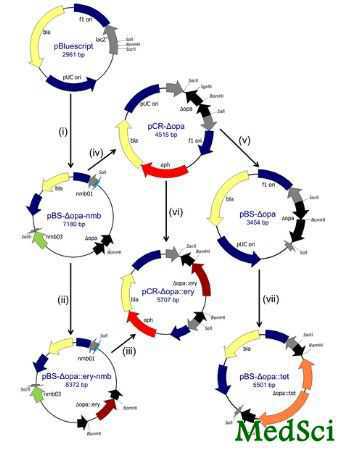PLOS ONE:新发现支持脑膜炎新疫苗的开发
2013-01-04 PLOS ONE 网络 gracezsq
牛津大学在本月的PLOS ONE期刊上发表了一项新研究结果,支持了脑膜炎球菌感染新疫苗的开发,该疫苗是基于脑膜炎球菌(脑膜炎奈瑟菌)的外膜蛋白Opa(Opacity-associated adhesin proteins)发挥预防作用的。 这项研究由牛津大学的临床讲师Manish Sadarangani博士领导,由儿童慈善行动医学研究所赞助。

牛津大学在本月的PLOS ONE期刊上发表了一项新研究结果,支持了脑膜炎球菌感染新疫苗的开发,该疫苗是基于脑膜炎球菌(脑膜炎奈瑟菌)的外膜蛋白Opa(Opacity-associated adhesin proteins)发挥预防作用的。
这项研究由牛津大学的临床讲师Manish Sadarangani博士领导,由儿童慈善行动医学研究所赞助。
脑膜炎球菌是引发英国儿童脑膜炎和败血病的首要原因。这种致命的细菌能在几个小时内使人死亡,致死的比例大约占其所感染儿童的十分之一,而且,即使幸存也会留下永久性并发症,如耳聋,癫痫,学习障碍等。某些感染者必须进行手指、脚趾和四肢截肢,这给他们带来了终生的不便。
目前已有针对A、C、W和Y血清型脑膜炎球菌的疫苗。但是,还没有针对B型脑膜炎球菌(MenB)所有菌株的疫苗被批准。
最近,已有关于新型疫苗Bexsero能够预防MenB的报道,并且预计短期内能够获得使用许可。乐观的是,新疫苗能够帮助控制一些由MenB引起的疾病,不幸的是,它的预防范围并没有覆盖B型脑膜炎球菌的所有菌株。
若想使MenB型脑膜炎成为历史,需要研发新的预防措施,而这项由行动医学研究所赞助的研究为脑膜炎的全面控制提供了新的见解。
Manish Sadarangani博士说:“MenB有非常多菌株,这些菌株的共同点之一就是Opa蛋白。我们一直在测试和分析Opa,看看是否能利用它来开发一种防范大多数MenB菌株的疫苗。这些研究结果使在我们研究将Opa作为MenB疫苗以防范儿童脑膜炎和败血病的道路上前进了一步。”
Manish Sadarangani博士在2010年申请了由行动医学研究所资助的三年研究培训助学金(RTF),在牛津大学研究脑膜炎,成为欧洲最大的进行儿童疫苗研究的学术小组——牛津大学疫苗组的一员。
在急诊室工作的实习医生Manish Sadarangani说道:“我记得有一次,一个两岁的孩子走进来,看起来有感冒和轻微发烧的症状。他的家长被告知,他们的孩子多半是感冒了,不用担心。第二天,这个孩子又回来了,全身布满了皮疹,几个小时后就死去了。不幸的是,脑膜炎的症状能和其它病的症状相似,不管怎么做,你都无法挽救他们。这也是我如此热情地投入到通过疫苗接种来预防感染的原因。”
与脑膜炎相关的拓展阅读:
- 二手烟会增加儿童患脑膜炎风险
- EMA支持首个B型脑膜炎球菌疫苗上市
- Ann Intern Med:注射污染的硬膜外类固醇制剂脑膜炎风险高,且伏立康唑有效
- 美国真菌性脑膜炎疫情影响18个州 死者升至25人
- 美真菌性脑膜炎致15人死亡 更多信息请点击:有关脑膜炎更多资讯

Abstract
Neisseria meningitidis is a major global pathogen causing invasive disease with a mortality of 5–10%. Most disease in developed countries is caused by serogroup B infection, against which there is no universal vaccine. Opacity-associated adhesin (Opa) proteins are major meningococcal outer membrane proteins, which have shown recent promise as a potential novel vaccine. Immunisation of mice with different Opa variants elicited high levels of meningococcal-specific bactericidal antibodies, demonstrating proof in principle for this approach. Opa proteins are critical in meningococcal pathogenesis, mediating bacterial adherence to host cells, and modulating human cellular immunity via interactions with T cells and neutrophils, although there are conflicting data regarding their effects on CD4+ T cells. We constructed Opa-positive and Opa-negative meningococcal strains to allow further evaluation of Opa as a vaccine component. All four opa genes from N. meningitidis strain H44/76 were sequentially disrupted to construct all possible combinations of N. meningitidis strains deficient in one, two, three, or all four opa genes. The transformations demonstrated that homologous recombination of exogenous DNA into the meningococcal chromosome can occur with as little as 80 bp, and that minor sequence differences are permissible. Anti-Opa bactericidal antibody responses following immunisation of mice with recombinant Opa were specific to the Opa variant used in immunisation. No immunomodulatory effects were observed when Opa was contained within meningococcal outer membrane vesicles (OMVs), compared to Opa-negative OMVs. These observations support the incorporation of Opa in meningococcal vaccines.
本网站所有内容来源注明为“梅斯医学”或“MedSci原创”的文字、图片和音视频资料,版权均属于梅斯医学所有。非经授权,任何媒体、网站或个人不得转载,授权转载时须注明来源为“梅斯医学”。其它来源的文章系转载文章,或“梅斯号”自媒体发布的文章,仅系出于传递更多信息之目的,本站仅负责审核内容合规,其内容不代表本站立场,本站不负责内容的准确性和版权。如果存在侵权、或不希望被转载的媒体或个人可与我们联系,我们将立即进行删除处理。
在此留言










#Plos one#
46
#新发现#
53
#新疫苗#
58